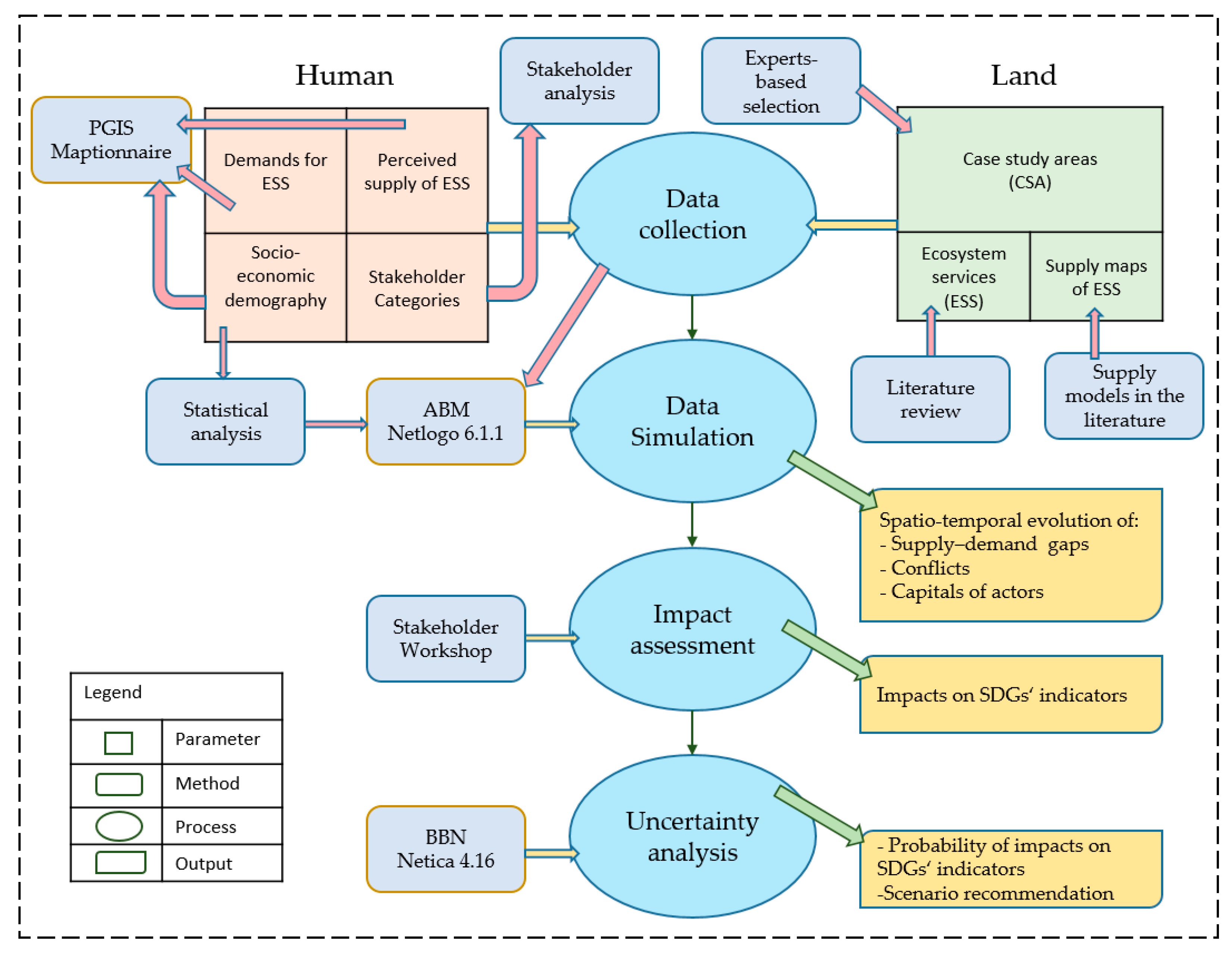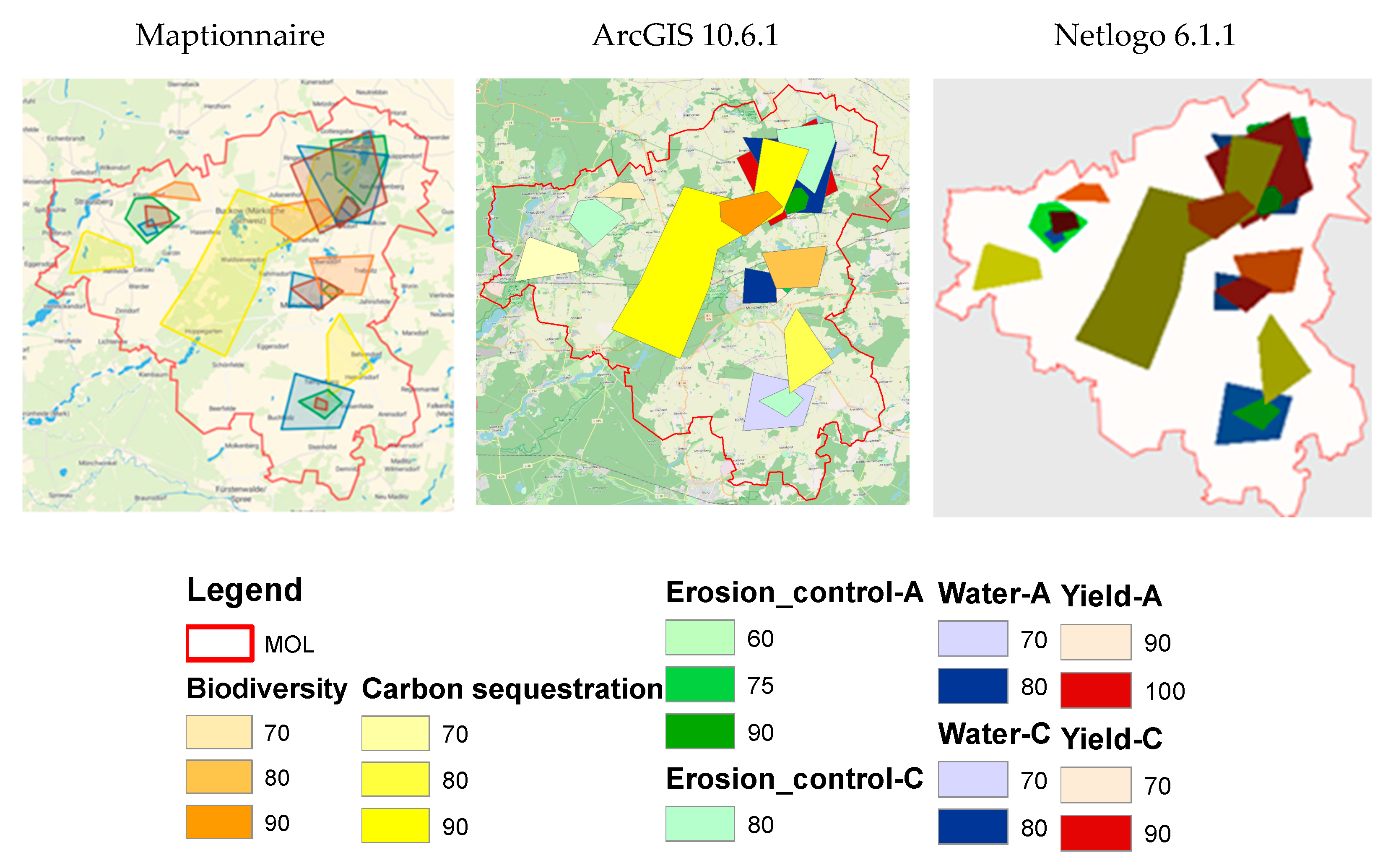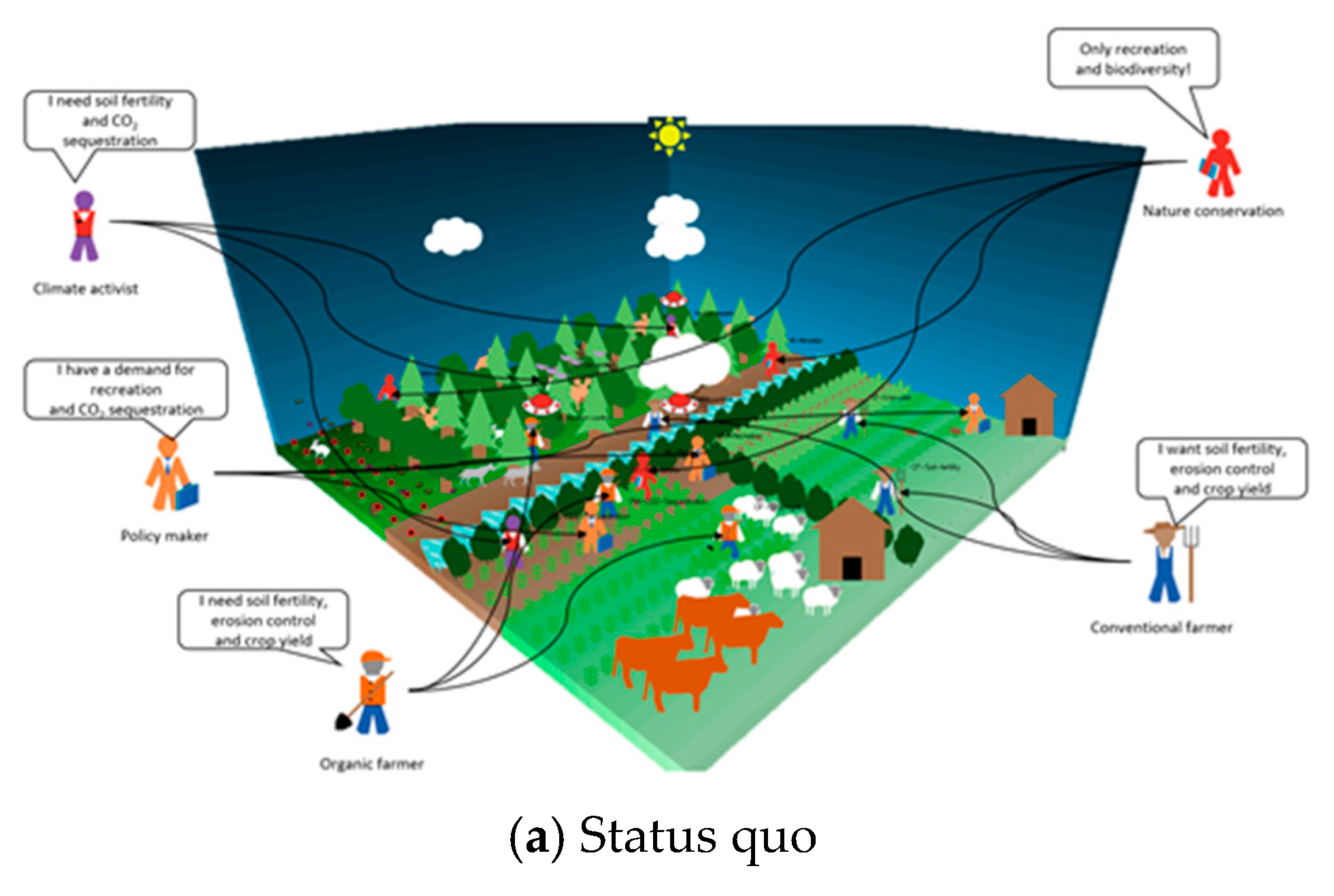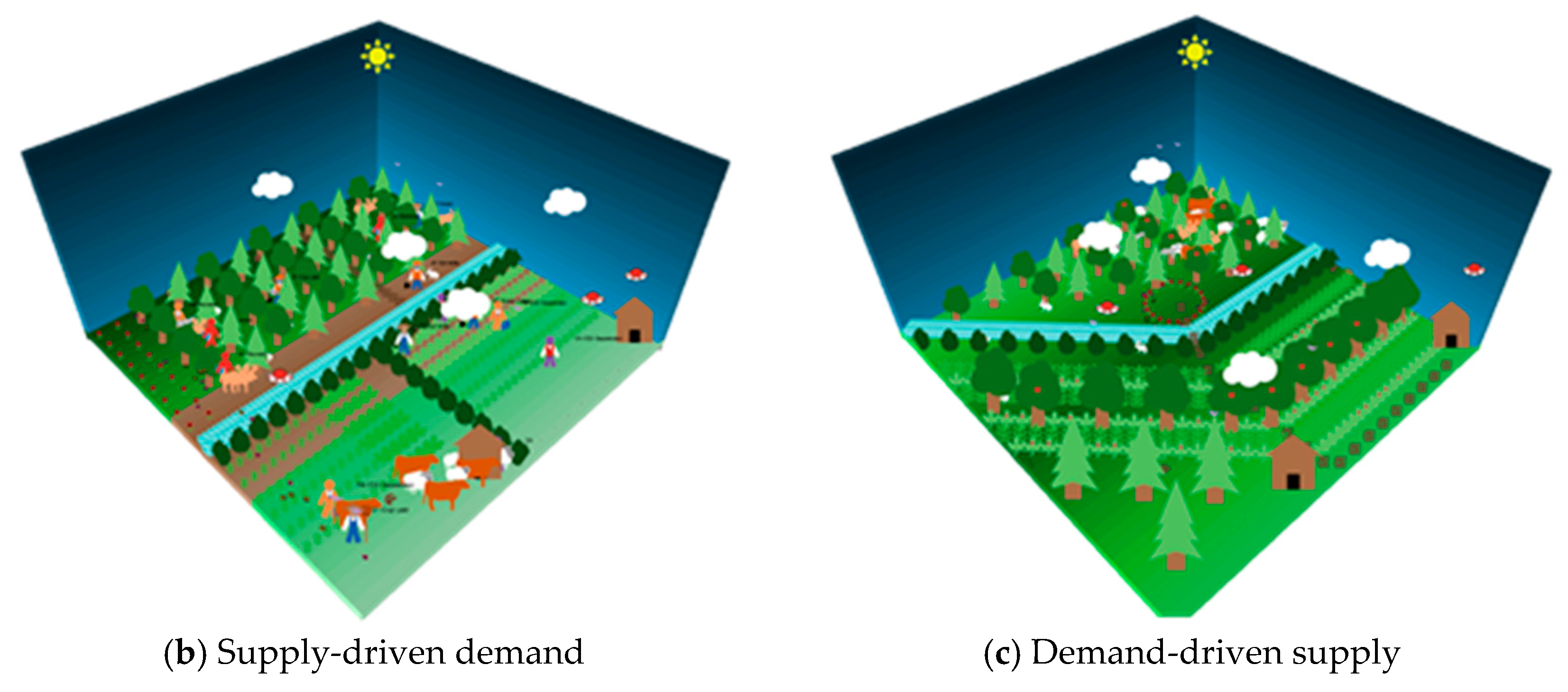A Conceptual Model Framework for Mapping, Analyzing and Managing Supply–Demand Mismatches of Ecosystem Services in Agricultural Landscapes
Abstract
1. Introduction
2. Challenges of Modelling Human–Environment Interactions
3. A Novel Integrated Conceptual Model
3.1. Participatory GIS
3.2. Agent-Based Modelling
3.3. Bayesian Belief Network
4. Decision Pathway Scenarios
5. Discussion and Conclusions
Supplementary Materials
Author Contributions
Funding
Institutional Review Board Statement
Informed Consent Statement
Data Availability Statement
Acknowledgments
Conflicts of Interest
References
- IPCC Summary for Policymakers. Climate Change and Land: An IPCC Special Report on Climate Change, Desertification, Land Degradation, Sustainable Land Management, Food Security, and Greenhouse Gas Fluxes in Terrestrial Ecosystems; IPCC: Geneva, Switzerland, 2019. [Google Scholar]
- Benton, T.; Bailey, R.; Froggatt, A.; King, R.; Lee, B.; Wellesley, L. Designing Sustainable Landuse in a 1.5 °C World: The Complexities of Projecting Multiple Ecosystem Services from Land. Curr. Opin. Environ. Sustain. 2018, 31, 88–95. [Google Scholar] [CrossRef]
- Millennium Ecosystem Assessment. Ecosystems and Human Well-Being: Synthesis; MEA, Ed.; Island Press: Washington, DC, USA, 2005; ISBN 978-1-59726-040-4. [Google Scholar]
- Costanza, R.; d’Arge, R.; de Groot, R.; Farber, S.; Grasso, M.; Hannon, B.; Limburg, K.; Naeem, S.; O’Neill, R.V.; Paruelo, J.; et al. The Value of the World’s Ecosystem Services and Natural Capital. Nature 1997, 387, 253–260. [Google Scholar] [CrossRef]
- Fagerholm, N.; Torralba, M.; Moreno, G.; Girardello, M.; Herzog, F.; Aviron, S.; Burgess, P.; Crous-Duran, J.; Ferreiro-Domínguez, N.; Graves, A.; et al. Cross-Site Analysis of Perceived Ecosystem Service Benefits in Multifunctional Landscapes. Glob. Environ. Chang. 2019, 56, 134–147. [Google Scholar] [CrossRef]
- Díaz, S.; Pascual, U.; Stenseke, M.; Martín-López, B.; Watson, R.T.; Molnár, Z.; Hill, R.; Chan, K.M.A.; Baste, I.A.; Brauman, K.A.; et al. Assessing Nature’s Contributions to People. Science 2018, 359, 270–272. [Google Scholar] [CrossRef] [PubMed]
- Peterson, G.D.; Harmáčková, Z.V.; Meacham, M.; Queiroz, C.; Jiménez-Aceituno, A.; Kuiper, J.J.; Malmborg, K.; Sitas, N.; Bennett, E.M. Welcoming Different Perspectives in IPBES: Nature Contributions to People and Ecosystem Services. Ecol. Soc. 2018, 23, art39. [Google Scholar] [CrossRef]
- Benton, T. Managing Agricultural Landscapes for Production of Multiple Services: The Policy Challenge. Politica Agric. Int. Int. Agric. Policy 2012, 7–17. [Google Scholar] [CrossRef]
- Gabriel, D.; Sait, S.M.; Hodgson, J.A.; Schmutz, U.; Kunin, W.E.; Benton, T.G. Scale Matters: The Impact of Organic Farming on Biodiversity at Different Spatial Scales: Scale Matters in Organic Farming. Ecol. Lett. 2010, 13, 858–869. [Google Scholar] [CrossRef]
- Sutherland, L.-A.; Gabriel, D.; Hathaway-Jenkins, L.; Pascual, U.; Schmutz, U.; Rigby, D.; Godwin, R.; Sait, S.M.; Sakrabani, R.; Kunin, W.E.; et al. The ‘Neighbourhood Effect’: A Multidisciplinary Assessment of the Case for Farmer Co-Ordination in Agri-Environmental Programmes. Land Use Policy 2012, 29, 502–512. [Google Scholar] [CrossRef]
- Scherr, S.J.; McNeely, J.A. Biodiversity Conservation and Agricultural Sustainability: Towards a New Paradigm of ‘Ecoagriculture’ Landscapes. Philos. Trans. R. Soc. B Biol. Sci. 2008, 363, 477–494. [Google Scholar] [CrossRef]
- Brady, M.; Sahrbacher, C.; Kellermann, K.; Happe, K. An Agent-Based Approach to Modeling Impacts of Agricultural Policy on Land Use, Biodiversity and Ecosystem Services. Landsc. Ecol. 2012, 27, 1363–1381. [Google Scholar] [CrossRef]
- Ungaro, F.; Zasada, I.; Piorr, A. Turning Points of Ecological Resilience: Geostatistical Modelling of Landscape Change and Bird Habitat Provision. Landsc. Urban. Plan. 2017, 157, 297–308. [Google Scholar] [CrossRef]
- Schaller, L.; Targetti, S.; Villanueva, A.J.; Zasada, I.; Kantelhardt, J.; Arriaza, M.; Bal, T.; Fedrigotti, V.B.; Giray, F.H.; Häfner, K.; et al. Agricultural Landscapes, Ecosystem Services and Regional Competitiveness—Assessing Drivers and Mechanisms in Nine European Case Study Areas. Land Use Policy 2018, 76, 735–745. [Google Scholar] [CrossRef]
- Zasada, I.; Weltin, M.; Reutter, M.; Verburg, P.H.; Piorr, A. EU’s Rural Development Policy at the Regional Level—Are Expenditures for Natural Capital Linked with Territorial Needs? Land Use Policy 2018, 77, 344–353. [Google Scholar] [CrossRef]
- Seppelt, R.; Lautenbach, S.; Volk, M. Identifying Trade-Offs between Ecosystem Services, Land Use, and Biodiversity: A Plea for Combining Scenario Analysis and Optimization on Different Spatial Scales. Curr. Opin. Environ. Sustain. 2013, 5, 458–463. [Google Scholar] [CrossRef]
- Lefebvre, M.; Espinosa, M.; Gomez y Paloma, S.; Paracchini, M.L.; Piorr, A.; Zasada, I. Agricultural Landscapes as Multi-Scale Public Good and the Role of the Common Agricultural Policy. J. Environ. Plan. Manag. 2015, 58, 2088–2112. [Google Scholar] [CrossRef]
- Knickel, K.; Maréchal, A. Stimulating the Social and Environmental Benefits of Agriculture and Forestry: An EU-Based Comparative Analysis. Land Use Policy 2018, 73, 320–330. [Google Scholar] [CrossRef]
- Zasada, I.; Piorr, A.; Novo, P.; Villanueva, A.J.; Valánszki, I. What Do We Know about Decision Support Systems for Landscape and Environmental Management? A Review and Expert Survey within EU Research Projects. Environ. Model. Softw. 2017, 98, 63–74. [Google Scholar] [CrossRef]
- Comberti, C.; Thornton, T.F.; Wyllie de Echeverria, V.; Patterson, T. Ecosystem Services or Services to Ecosystems? Valuing Cultivation and Reciprocal Relationships between Humans and Ecosystems. Glob. Environ. Change 2015, 34, 247–262. [Google Scholar] [CrossRef]
- Burkhard, B.; Maes, J. Mapping Ecosystem Services; Pensoft Publishers: Sofia, Bulgaria, 2017; ISBN 978-954-642-829-5. [Google Scholar]
- Wolff, S.; Schulp, C.J.E.; Verburg, P.H. Mapping Ecosystem Services Demand: A Review of Current Research and Future Perspectives. Ecol. Indic. 2015, 55, 159–171. [Google Scholar] [CrossRef]
- Baró, F.; Palomo, I.; Zulian, G.; Vizcaino, P.; Haase, D.; Gómez-Baggethun, E. Mapping Ecosystem Service Capacity, Flow and Demand for Landscape and Urban Planning: A Case Study in the Barcelona Metropolitan Region. Land Use Policy 2016, 57, 405–417. [Google Scholar] [CrossRef]
- Villamagna, A.M.; Angermeier, P.L.; Bennett, E.M. Capacity, Pressure, Demand, and Flow: A Conceptual Framework for Analyzing Ecosystem Service Provision and Delivery. Ecol. Complex. 2013, 15, 114–121. [Google Scholar] [CrossRef]
- Wang, L.; Zheng, H.; Wen, Z.; Liu, L.; Robinson, B.E.; Li, R.; Li, C.; Kong, L. Ecosystem Service Synergies/Trade-Offs Informing the Supply-Demand Match of Ecosystem Services: Framework and Application. Ecosyst. Serv. 2019, 37, 100939. [Google Scholar] [CrossRef]
- Nedkov, S.; Burkhard, B. Flood Regulating Ecosystem Services—Mapping Supply and Demand, in the Etropole Municipality, Bulgaria. Ecol. Indic. 2012, 21, 67–79. [Google Scholar] [CrossRef]
- Verhagen, W.; Kukkala, A.S.; Moilanen, A.; van Teeffelen, A.J.A.; Verburg, P.H. Use of Demand for and Spatial Flow of Ecosystem Services to Identify Priority Areas: Demand and Flow of Ecosystem Services. Conserv. Biol. 2017, 31, 860–871. [Google Scholar] [CrossRef] [PubMed]
- Syrbe, R.-U.; Grunewald, K. Ecosystem Service Supply and Demand—The Challenge to Balance Spatial Mismatches. Int. J. Biodivers. Sci. Ecosyst. Serv. Manag. 2017, 13, 148–161. [Google Scholar] [CrossRef]
- King, E.; Cavender-Bares, J.; Balvanera, P.; Mwampamba, T.H.; Polasky, S. Trade-Offs in Ecosystem Services and Varying Stakeholder Preferences: Evaluating Conflicts, Obstacles, and Opportunities. Ecol. Soc. 2015, 20, art25. [Google Scholar] [CrossRef]
- Kovács, E.; Kelemen, E.; Kalóczkai, Á.; Margóczi, K.; Pataki, G.; Gébert, J.; Málovics, G.; Balázs, B.; Roboz, Á.; Krasznai Kovács, E.; et al. Understanding the Links between Ecosystem Service Trade-Offs and Conflicts in Protected Areas. Ecosyst. Serv. 2015, 12, 117–127. [Google Scholar] [CrossRef]
- Setälä, H.; Bardgett, R.D.; Birkhofer, K.; Brady, M.; Byrne, L.; de Ruiter, P.C.; de Vries, F.T.; Gardi, C.; Hedlund, K.; Hemerik, L.; et al. Urban and Agricultural Soils: Conflicts and Trade-Offs in the Optimization of Ecosystem Services. Urban. Ecosyst. 2014, 17, 239–253. [Google Scholar] [CrossRef]
- Geijzendorffer, I.R.; Martín-López, B.; Roche, P.K. Improving the Identification of Mismatches in Ecosystem Services Assessments. Ecol. Indic. 2015, 52, 320–331. [Google Scholar] [CrossRef]
- Shaaban, M.; Scheffran, J.; Böhner, J.; Elsobki, M.S. A Dynamic Sustainability Analysis of Energy Landscapes in Egypt: A Spatial Agent-Based Model Combined with Multi-Criteria Decision Analysis. J. Artif. Soc. Soc. Simul. 2019, 22. [Google Scholar] [CrossRef]
- Ostrom, E. A General Framework for Analyzing Sustainability of Social-Ecological Systems. Science 2009, 325, 419–422. [Google Scholar] [CrossRef] [PubMed]
- Miyasaka, T.; Le, Q.B.; Okuro, T.; Zhao, X.; Takeuchi, K. Agent-Based Modeling of Complex Social–Ecological Feedback Loops to Assess Multi-Dimensional Trade-Offs in Dryland Ecosystem Services. Landsc. Ecol. 2017, 32, 707–727. [Google Scholar] [CrossRef]
- Bareille, F.; Boussard, H.; Thenail, C. Productive Ecosystem Services and Collective Management: Lessons from a Realistic Landscape Model. Ecol. Econ. 2020, 169, 106482. [Google Scholar] [CrossRef]
- Benton, T.; Dougill, A.; Fraser, E.; Howlett, D. The Scale for Managing Production vs the Scale Required for Ecosystem Service Production. World Agric. 2011, 11. [Google Scholar]
- Bagstad, K.J.; Semmens, D.J.; Waage, S.; Winthrop, R. A Comparative Assessment of Decision-Support Tools for Ecosystem Services Quantification and Valuation. Ecosyst. Serv. 2013, 5, 27–39. [Google Scholar] [CrossRef]
- Sharp, R.; Tallis, H.T.; Ricketts, T.; Guerry, A.D.; Wood, S.A.; Chaplin-Kramer, R.; Nelson, E.; Ennaanay, D.; Wolny, S.; Olwero, N.; et al. InVEST 3.8.4.Post3+ug.G3731663 User’s Guide. The Natural Capital Project, Stanford University, University of Minnesota, The Nature Conservancy, and World Wildlife Fund. Available online: https://storage.googleapis.com/releases.naturalcapitalproject.org/invest-userguide/latest/index.html (accessed on 18 June 2020).
- Villa, F.; Bagstad, K.; Johnson, G.; Voigt, B. Scientific Instruments for Climate Change Adaptation: Estimating and Optimizing the Efficiency of Ecosystem Service Provision. Econ. Agrar. Recur. Nat. 2011, 11, 83. [Google Scholar] [CrossRef]
- Villa, F.; Bagstad, K.J.; Voigt, B.; Johnson, G.W.; Portela, R.; Honzák, M.; Batker, D. A Methodology for Adaptable and Robust Ecosystem Services Assessment. PLoS ONE 2014, 9, e91001. [Google Scholar] [CrossRef]
- Boumans, R.; Roman, J.; Altman, I.; Kaufman, L. The Multiscale Integrated Model of Ecosystem Services (MIMES): Simulating the Interactions of Coupled Human and Natural Systems. Ecosyst. Serv. 2015, 12, 30–41. [Google Scholar] [CrossRef]
- Voinov, A.; Jenni, K.; Gray, S.; Kolagani, N.; Glynn, P.D.; Bommel, P.; Prell, C.; Zellner, M.; Paolisso, M.; Jordan, R.; et al. Tools and Methods in Participatory Modeling: Selecting the Right Tool for the Job. Environ. Model. Softw. 2018, 109, 232–255. [Google Scholar] [CrossRef]
- Weltin, M.; Zasada, I.; Franke, C.; Piorr, A.; Raggi, M.; Viaggi, D. Analysing Behavioural Differences of Farm Households: An Example of Income Diversification Strategies Based on European Farm Survey Data. Land Use Policy 2017, 62, 172–184. [Google Scholar] [CrossRef]
- Burkhard, B.; Kroll, F.; Nedkov, S.; Müller, F. Mapping Ecosystem Service Supply, Demand and Budgets. Ecol. Indic. 2012, 21, 17–29. [Google Scholar] [CrossRef]
- Baró, F.; Haase, D.; Gómez-Baggethun, E.; Frantzeskaki, N. Mismatches between Ecosystem Services Supply and Demand in Urban Areas: A Quantitative Assessment in Five European Cities. Ecol. Indic. 2015, 55, 146–158. [Google Scholar] [CrossRef]
- Sherrouse, B.C.; Clement, J.M.; Semmens, D.J. A GIS Application for Assessing, Mapping, and Quantifying the Social Values of Ecosystem Services. Appl. Geogr. 2011, 31, 748–760. [Google Scholar] [CrossRef]
- Willemen, L. Mapping and Modelling Multifunctional Landscapes; Wageningen University: Wageningen, The Netherlands, 2010; ISBN 978-90-8585-626-9. [Google Scholar]
- Haines-Young, R.; Potschin, M. The links between biodiversity, ecosystem services and human well-being. In Ecosystem Ecology; Raffaelli, D.G., Frid, C.L.J., Eds.; Cambridge University Press: Cambridge, UK, 2010; pp. 110–139. ISBN 978-0-511-75045-8. [Google Scholar]
- Bagstad, K.J.; Villa, F.; Batker, D.; Harrison-Cox, J.; Voigt, B.; Johnson, G.W. From Theoretical to Actual Ecosystem Services: Mapping Beneficiaries and Spatial Flows in Ecosystem Service Assessments. Ecol. Soc. 2014, 19, art64. [Google Scholar] [CrossRef]
- Maptionnaire | Community Engagement Platform. Available online: https://maptionnaire.com (accessed on 13 January 2021).
- Gilbert, G.N. Agent-Based Models; Quantitative Applications in the Social Sciences; Sage Publications: Los Angeles, CA, USA, 2008; ISBN 978-1-4129-4964-4. [Google Scholar]
- Janssen, M.; Ostrom, E. Empirically Based, Agent-Based Models. Ecol. Soc. 2006, 11. [Google Scholar] [CrossRef]
- Agent-Based Computational Modelling. Contributions to Economics; Billari, F.C., Fent, T., Prskawetz, A., Scheffran, J., Eds.; Physica-Verlag HD: Heidelberg, Germany, 2006; ISBN 978-3-7908-1640-2. [Google Scholar]
- Happe, K.; Balmann, A.; Kellermann, K. The Agricultural Policy Simulator (AgriPoliS): An. Agent-Based Model. to Study Structural Change in Agriculture (Version 1.0); Leibniz-Institut für Agrarentwicklung in Mittel- und Osteuropa (IAMO): Halle (Salle), Germany, 2004. [Google Scholar]
- Piorr, A.; Ungaro, F.; Ciancaglini, A.; Happe, K.; Sahrbacher, A.; Sattler, C.; Uthes, S.; Zander, P. Integrated Assessment of Future CAP Policies: Land Use Changes, Spatial Patterns and Targeting. Environ. Sci. Policy 2009, 12, 1122–1136. [Google Scholar] [CrossRef]
- Le, Q.B.; Park, S.J.; Vlek, P.L.G.; Cremers, A.B. Land-Use Dynamic Simulator (LUDAS): A Multi-Agent System Model for Simulating Spatio-Temporal Dynamics of Coupled Human–Landscape System. I. Structure and Theoretical Specification. Ecol. Inform. 2008, 3, 135–153. [Google Scholar] [CrossRef]
- Le, Q.B.; Park, S.J.; Vlek, P.L.G. Land Use Dynamic Simulator (LUDAS): A Multi-Agent System Model for Simulating Spatio-Temporal Dynamics of Coupled Human–Landscape System. Ecol. Inform. 2010, 5, 203–221. [Google Scholar] [CrossRef]
- Sun, Z.; Müller, D. A Framework for Modeling Payments for Ecosystem Services with Agent-Based Models, Bayesian Belief Networks and Opinion Dynamics Models. Environ. Model. Softw. 2013, 45, 15–28. [Google Scholar] [CrossRef]
- Pohle, D.; Zasada, I. CLAIM Knowledge Platform. Available online: http://claimknowledgeplatform.eu/ (accessed on 18 June 2020).
- Chen, X.; Viña, A.; Shortridge, A.; An, L.; Liu, J. Assessing the Effectiveness of Payments for Ecosystem Services: An Agent-Based Modeling Approach. Ecol. Soc. 2014, 19, art7. [Google Scholar] [CrossRef]
- Habib, T.J.; Heckbert, S.; Wilson, J.J.; Vandenbroeck, A.J.K.; Cranston, J.; Farr, D.R. Impacts of Land-Use Management on Ecosystem Services and Biodiversity: An Agent-Based Modelling Approach. PeerJ 2016, 4, e2814. [Google Scholar] [CrossRef] [PubMed][Green Version]
- Tieskens, K.F.; Shaw, B.J.; Haer, T.; Schulp, C.J.E.; Verburg, P.H. Cultural Landscapes of the Future: Using Agent-Based Modeling to Discuss and Develop the Use and Management of the Cultural Landscape of South West Devon. Landsc. Ecol. 2017, 32, 2113–2132. [Google Scholar] [CrossRef]
- Schulze, J.; Müller, B.; Groeneveld, J.; Grimm, V. Agent-Based Modelling of Social-Ecological Systems: Achievements, Challenges, and a Way Forward. J. Artif. Soc. Soc. Simul. 2017, 20, 8. [Google Scholar] [CrossRef]
- Shaaban, M.; Scheffran, J.; Böhner, J.; Elsobki, M.S. Energy Landscape Transition Analysis and Planning in Egypt (ELTAP-Egy Version 1.0.0); CoMSES Net Computational Model Library: Cartagena, Colombia, 2018. [Google Scholar] [CrossRef]
- BenDor, T.K.; Scheffran, J. Agent-Based Modeling of Environmental Conflict and Cooperation; Taylor & Francis: Boca Raton, FL, USA, 2018; ISBN 978-1-138-47603-5. [Google Scholar]
- Scheffran, J.; BenDor, T. Bioenergy and Land Use: A Spatial-Agent Dynamic Model of Energy Crop Production in Illinois. Int. J. Environ. Pollut. 2009, 39, 4. [Google Scholar] [CrossRef]
- Bebbington, A. Capitals and Capabilities: A Framework for Analyzing Peasant Viability, Rural Livelihoods and Poverty. World Dev. 1999, 27, 2021–2044. [Google Scholar] [CrossRef]
- Ashley, C.; Carney, D. Sustainable Livelihoods: Lessons from Early Experience; Department for International Development: London, UK, 1999; ISBN 978-0-85003-419-6. [Google Scholar]
- Ostrom, E. Social capital: A fad or a fundamental concept. In Social Capital: A Multifaceted Perspective; Serageldin, I., Ed.; World Bank: Washington, DC, USA, 1999; pp. 172–215. [Google Scholar]
- Ellis, F. Rural Livelihoods and Diversity in Developing Countries; Oxford University Press: Oxford, UK, 2000. [Google Scholar]
- Wu, C.-C.; Tsai, H.-M. A Capital-Based Framework for Assessing Coastal and Marine Social–Ecological Dynamics and Natural Resource Management: A Case Study of Penghu Archipelago. J. Mar. Isl. Cult. 2014, 3, 60–68. [Google Scholar] [CrossRef]
- Wilensky, U. NetLogo; Center for Connected Learning and Computer-Based Modeling; Northwestern University: Evanston, IL, USA, 1999. [Google Scholar]
- Geijzendorffer, I.R.; Cohen-Shacham, E.; Cord, A.F.; Cramer, W.; Guerra, C.; Martín-López, B. Ecosystem Services in Global Sustainability Policies. Environ. Sci. Policy 2017, 74, 40–48. [Google Scholar] [CrossRef]
- Wood, S.L.R.; Jones, S.K.; Johnson, J.A.; Brauman, K.A.; Chaplin-Kramer, R.; Fremier, A.; Girvetz, E.; Gordon, L.J.; Kappel, C.V.; Mandle, L.; et al. Distilling the Role of Ecosystem Services in the Sustainable Development Goals. Ecosyst. Serv. 2018, 29, 70–82. [Google Scholar] [CrossRef]
- Mann, C.; Garcia-Martin, M.; Raymond, C.M.; Shaw, B.J.; Plieninger, T. The Potential for Integrated Landscape Management to Fulfil Europe’s Commitments to the Sustainable Development Goals. Landsc. Urban. Plan. 2018, 177, 75–82. [Google Scholar] [CrossRef]
- Johnson, J.A.; Jones, S.K.; Wood, S.L.R.; Chaplin-Kramer, R.; Hawthorne, P.L.; Mulligan, M.; Pennington, D.; DeClerck, F.A. Mapping Ecosystem Services to Human Well-being: A Toolkit to Support Integrated Landscape Management for the SDGs. Ecol. Appl. 2019, 29. [Google Scholar] [CrossRef]
- Griggs, D.; Stafford Smith, M.; Rockström, J.; Öhman, M.C.; Gaffney, O.; Glaser, G.; Kanie, N.; Noble, I.; Steffen, W.; Shyamsundar, P. An Integrated Framework for Sustainable Development Goals. Ecol. Soc. 2014, 19, art49. [Google Scholar] [CrossRef]
- Costanza, R.; Daly, L.; Fioramonti, L.; Giovannini, E.; Kubiszewski, I.; Mortensen, L.F.; Pickett, K.E.; Ragnarsdottir, K.V.; De Vogli, R.; Wilkinson, R. Modelling and Measuring Sustainable Wellbeing in Connection with the UN Sustainable Development Goals. Ecol. Econ. 2016, 130, 350–355. [Google Scholar] [CrossRef]
- Schirpke, U.; Egarter Vigl, L.; Tasser, E.; Tappeiner, U. Analyzing Spatial Congruencies and Mismatches between Supply, Demand and Flow of Ecosystem Services and Sustainable Development. Sustainability 2019, 11, 2227. [Google Scholar] [CrossRef]
- Wolff, S.; Schulp, C.J.E.; Kastner, T.; Verburg, P.H. Quantifying Spatial Variation in Ecosystem Services Demand: A Global Mapping Approach. Ecol. Econ. 2017, 136, 14–29. [Google Scholar] [CrossRef]
- Uusitalo, L. Advantages and Challenges of Bayesian Networks in Environmental Modelling. Ecol. Model. 2007, 203, 312–318. [Google Scholar] [CrossRef]
- Landuyt, D.; Broekx, S.; D’hondt, R.; Engelen, G.; Aertsens, J.; Goethals, P.L.M. A Review of Bayesian Belief Networks in Ecosystem Service Modelling. Environ. Model. Softw. 2013, 46, 1–11. [Google Scholar] [CrossRef]
- Duespohl, M.; Frank, S.; Doell, P. A Review of Bayesian Networks as a Participatory Modeling Approach in Support of Sustainable Environmental Management. J. Sustain. Dev. 2012, 5, p1. [Google Scholar] [CrossRef]
- Haines-Young, R. Exploring Ecosystem Service Issues across Diverse Knowledge Domains Using Bayesian Belief Networks. Prog. Phys. Geogr. Earth Environ. 2011, 35, 681–699. [Google Scholar] [CrossRef]
- Kerebel, A.; Gélinas, N.; Déry, S.; Voigt, B.; Munson, A. Landscape Aesthetic Modelling Using Bayesian Networks: Conceptual Framework and Participatory Indicator Weighting. Landsc. Urban. Plan. 2019, 185, 258–271. [Google Scholar] [CrossRef]
- Landuyt, D.; Broekx, S.; Goethals, P.L.M. Bayesian Belief Networks to Analyse Trade-Offs among Ecosystem Services at the Regional Scale. Ecol. Indic. 2016, 71, 327–335. [Google Scholar] [CrossRef]
- Poppenborg, P.; Koellner, T. A Bayesian Network Approach to Model Farmers’ Crop Choice Using Socio-Psychological Measurements of Expected Benefits of Ecosystem Services. Environ. Model. Softw. 2014, 57, 227–234. [Google Scholar] [CrossRef]
- McVittie, A.; Norton, L.; Martin-Ortega, J.; Siameti, I.; Glenk, K.; Aalders, I. Operationalizing an Ecosystem Services-Based Approach Using Bayesian Belief Networks: An Application to Riparian Buffer Strips. Ecol. Econ. 2015, 110, 15–27. [Google Scholar] [CrossRef]
- Pérez-Miñana, E.; Krause, P.J.; Thornton, J. Bayesian Networks for the Management of Greenhouse Gas Emissions in the British Agricultural Sector. Environ. Model. Softw. 2012, 35, 132–148. [Google Scholar] [CrossRef]
- Wang, Q.J.; Robertson, D.E.; Haines, C.L. A Bayesian Network Approach to Knowledge Integration and Representation of Farm Irrigation: 1. Model Development: Knowledge Integration of Farm Irrigation, 1. Water Resour. Res. 2009, 45. [Google Scholar] [CrossRef]
- Nash, D.; Waters, D.; Buldu, A.; Wu, Y.; Lin, Y.; Yang, W.; Song, Y.; Shu, J.; Qin, W.; Hannah, M. Using a Conceptual Bayesian Network to Investigate Environmental Management of Vegetable Production in the Lake Taihu Region of China. Environ. Model. Softw. 2013, 46, 170–181. [Google Scholar] [CrossRef]
- Henriksen, H.J.; Kjær, J.; Brüsh, W.; Jacobsen, L.-B.; Jensen, J.D.; Grinderslev, D.; Andersen, P. Environmental Benefits and Social Cost—An Example of Combining Bayesian Networks and Economic Models for Analysing Pesticide Management Instruments. Hydrol. Res. 2007, 38, 351–371. [Google Scholar] [CrossRef]
- Cain, J. Planning Improvements in Natural Resources Management: Guidelines for Using Bayesian Networks to Support. the Planning and Management of Development Programmes in the Water Sector and Beyond; Centre for Ecology and Hydrology: Wallingford, UK, 2001; ISBN 0 903741 00 9. [Google Scholar]
- GRI Standards Getting Started with the GRI Standards. Available online: https://www.globalreporting.org/standards/getting-started-with-the-gri-standards/ (accessed on 1 July 2020).
- Cole, A. The Influence Matrix Methodology: A Technical Report; Landscape Report: Palmerston North, New Zealand, 2006. [Google Scholar]
- Netica v 4.16. Norsys—Download Netica Application; Norsys Software Corp.: Vancouver, BC, Canada, 1998. [Google Scholar]
- Kjærulff, U.B.; Madsen, A.L. Bayesian Networks and Influence Diagrams: A Guide to Construction and Analysis; Information Science and Statistics; Springer New York: New York, NY, USA, 2013; Volume 22, ISBN 978-1-4614-5103-7. [Google Scholar]
- Dietzenbacher, E. On the Relationship between the Supply-Driven and the Demand-Driven Input—Output Model. Environ. Plan. Econ. Space 1989, 21, 1533–1539. [Google Scholar] [CrossRef]
- Amit, R.K.; Mehta, P.; Tripathi, R.R. Optimal Shelf-Space Stocking Policy Using Stochastic Dominance under Supply-Driven Demand Uncertainty. Eur. J. Oper. Res. 2015, 246, 339–342. [Google Scholar] [CrossRef]
- Motoyama, Y.; Malizia, E. Demand Pull or Supply Push? Metro-Level Analysis of Start-Ups in the United States. Reg. Stud. Reg. Sci. 2017, 4, 232–246. [Google Scholar] [CrossRef]
- Zasada, I.; Schmutz, U.; Wascher, D.; Kneafsey, M.; Corsi, S.; Mazzocchi, C.; Monaco, F.; Boyce, P.; Doernberg, A.; Sali, G.; et al. Food beyond the City—Analysing Foodsheds and Self-Sufficiency for Different Food System Scenarios in European Metropolitan Regions. City Cult. Soc. 2019, 16, 25–35. [Google Scholar] [CrossRef]
- Weltin, M.; Zasada, I.; Piorr, A.; Debolini, M.; Geniaux, G.; Moreno Perez, O.; Scherer, L.; Tudela Marco, L.; Schulp, C.J.E. Conceptualising Fields of Action for Sustainable Intensification—A Systematic Literature Review and Application to Regional Case Studies. Agric. Ecosyst. Environ. 2018, 257, 68–80. [Google Scholar] [CrossRef]





| Capability of Producing Outputs | ||||||||||||
| Spatial representation | Temporal representation | Qualitative forecast | Quantitative forecast | Ease of communicating results | Transparency | Ease of modification | Feedback loops supported | Handling uncertainty | ||||
| GIS | H | L | L | L | H | M | H | L | L | |||
| ABM | H | H | H | H | M | L | M | H | H | |||
| BBN | L | L | M | M | L/M | L/M | M | L | M | |||
| Requirements | ||||||||||||
| Time and cost | Empirical data | Systems knowledge | Expertise of modelers | Methodological expertise of stakeholders | Computer resources | |||||||
| GIS | M | H | L/M | M | L | H | ||||||
| ABM | M/H | L/M | H | H | L/M | H | ||||||
| BBN | M/H | M | M | M/H | M | M | ||||||
Publisher’s Note: MDPI stays neutral with regard to jurisdictional claims in published maps and institutional affiliations. |
© 2021 by the authors. Licensee MDPI, Basel, Switzerland. This article is an open access article distributed under the terms and conditions of the Creative Commons Attribution (CC BY) license (http://creativecommons.org/licenses/by/4.0/).
Share and Cite
Shaaban, M.; Schwartz, C.; Macpherson, J.; Piorr, A. A Conceptual Model Framework for Mapping, Analyzing and Managing Supply–Demand Mismatches of Ecosystem Services in Agricultural Landscapes. Land 2021, 10, 131. https://doi.org/10.3390/land10020131
Shaaban M, Schwartz C, Macpherson J, Piorr A. A Conceptual Model Framework for Mapping, Analyzing and Managing Supply–Demand Mismatches of Ecosystem Services in Agricultural Landscapes. Land. 2021; 10(2):131. https://doi.org/10.3390/land10020131
Chicago/Turabian StyleShaaban, Mostafa, Carmen Schwartz, Joseph Macpherson, and Annette Piorr. 2021. "A Conceptual Model Framework for Mapping, Analyzing and Managing Supply–Demand Mismatches of Ecosystem Services in Agricultural Landscapes" Land 10, no. 2: 131. https://doi.org/10.3390/land10020131
APA StyleShaaban, M., Schwartz, C., Macpherson, J., & Piorr, A. (2021). A Conceptual Model Framework for Mapping, Analyzing and Managing Supply–Demand Mismatches of Ecosystem Services in Agricultural Landscapes. Land, 10(2), 131. https://doi.org/10.3390/land10020131






